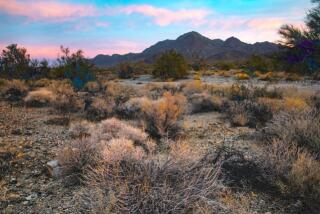Ruling will allow Mojave Desert outcropping to again feature a cross
- Share via
A dying man’s request is nothing Henry and Wanda Sandoz take lightly. So when the sick and elderly Riley Bembry asked the couple nearly 30 years ago to maintain a memorial and a cross atop a lonely outcropping in the middle of the Mojave Desert long after he was gone, they had to say yes.
The Sandozes never anticipated that their stewardship would take them one day to the Supreme Court, nor did they anticipate ever seeing a cross — Bembry’s legacy, since removed — erected once again on what is known as Sunrise Rock.
But Monday, the U.S. District Court for the Central District of California took a step toward making that possible by approving a land exchange that would remove Sunrise Rock from the Mojave National Preserve.
The Sandozes played a role in that arrangement by offering five acres they own in the preserve for the Sunrise Rock parcel, according to Linda Slater, resource interpreter for the preserve. With the rock in private hands, a cross can be displayed there.
Upon receiving the deed, the Sandozes will donate the property to the state office of the Veterans of Foreign Wars in Sacramento, said Wanda, 68.
“We’re very excited,” she said, “but until we see that cross back in place, we’re not going to rest.”
Surveys and appraisals of the properties remain to be done before the exchange can be completed.
The controversy over Sunrise Rock, southeast of Baker, began in 1999 when the National Park Service, which oversees the preserve, denied the request to build a Buddhist shrine on the outcropping and announced its intention to remove an 8-foot-tall cross, one of a succession of crosses that had been there since 1934 memorializing veterans of World War I.
In 2000, Congress reacted and passed legislation prohibiting the use of government funds to take down the cross, and in 2001, a former park service employee, with the backing of the American Civil Liberties Union, filed a lawsuit against the National Park Service for refusing to remove the cross.
A judge ordered that the cross be covered with a wooden box until the matter was resolved.
In 2003, Congress attempted to resolve the suit by directing the secretary of the Interior to transfer the land to a private party, but a district court and the 9th Circuit Court of Appeals prohibited the transfer. In 2010, the Supreme Court in a 5-4 ruling reversed those decisions.
Not long after that ruling, the cross, constructed out of metal pipe 4 inches in diameter, was stolen. Even though a $25,000 reward was offered for its return, it has never been recovered.
Once the property transfer is completed later this year, the Sandozes, who lived in the Mojave near the Nevada border before recently moving to Yucca Valley, plan to reinstall a cross on the outcropping. Henry Sandoz, 72, has already built the one they intend to use.
“We’ve been in Washington, D.C., and seen all those war memorials,” Wanda said. “They’re beautiful and wonderful, but they don’t hold a candle to this one.”
Sunrise Rock appealed to miners in the region who had served in World War I because the rock, according to Henry, has an area of weathering in a shape that resembles a doughboy.
The National Park Service plans to install a fence around the parcel, allowing for two entrances to the site. The agency will also post signs to indicate that it is private property, along with a plaque describing the memorial.
More to Read
Sign up for Essential California
The most important California stories and recommendations in your inbox every morning.
You may occasionally receive promotional content from the Los Angeles Times.











